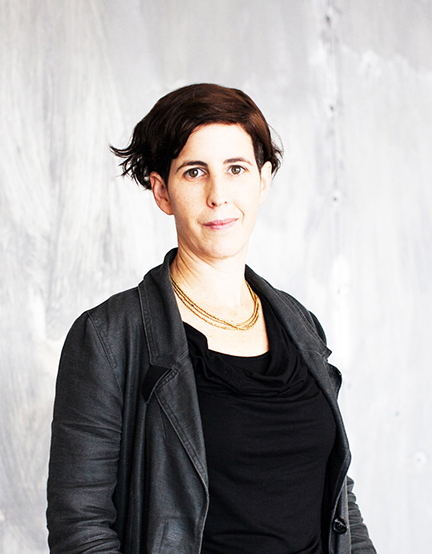Selena Pinnell in Testimony.
After Selena Pinnell was raped in her bedroom in 2009, she couldn’t re-enter for weeks, she says. Instead, she slept on the couch in her living room, trying to figure out how to process what had happened. Finally, three weeks later, she and her roommate opened the door, removed all the blankets from her bed, and threw out her mattress. Soon after, she found herself staring into the mirror, chopping off her hair until she had none left. "I wanted to cut away anything that made me feel feminine. I wanted to strip myself of anything that made me desirable. I wanted to become invisible. That felt safe," she says in Testimony, a VR documentary about how survivors of sexual assault cope in the aftermath of their attacks.For Pinnell, like so many other survivors, the healing process has been long and complicated. After her rape, she attempted to "bury [the experience] as deep as possible," she says in Testimony. But about a year later, she began having serious nerve pain, then began sporadically losing feeling in her hands and feet. Finally, she was diagnosed with severe PTSD and was hospitalized for several weeks. After a year and a half of somatic therapy, she says her pain finally began to go away.For more than five years, Pinnell barely told anyone what had happened due to feelings of shame and discomfort. But for her 34th birthday, she decided to open up to her family and close friends by recording a simple video of her story, uploading it onto YouTube, and sending her loved ones the link—an act that she says made her feel "so much lighter in so many ways."Seven months later, Pinnell met Brooklyn-based experimental video artist and filmmaker Zohar Kfir. Pinnell and her husband, René, co-founded and run Kaleidoscope VR in Portland, Oregon, and did a VR accelerator program in collaboration with Oculus in the fall of 2016. Kfir pitched Testimony to be in the program. After her presentation, Pinnell ran up to Kfir and told her that she wanted to be her first subject. Within a week, Pinnell had recorded her story in one take.Testimony premiered at the Tribeca Film Festival in the spring of 2017 as a VR experience for Oculus Rift. The first release of the project included five stories of surviving sexual assault—including that of Pinnell, who is also the Creative Producer of the project and contributed to its filming. Kfir has since expanded the unconventional documentary to include 16 testimonies and, on Wednesday, will release an adapted WebVR version online, making it accessible to those without VR gear as well. Kfir is also inviting survivors to add their own testimonies to the project and this spring will be touring the full VR version across America on college campuses—including fraternity viewings—collecting testimonies along the way. Since the documentary’s debut at Tribeca, Kfir says she has received several emails a week from survivors who also want to share their stories. And after the #MeToo movement rallied women across the US to speak out about their own experiences with sexual harassment and abuse, she’s hoping that more people will be emboldened to participate and that the platform can function as an archive to help capture this watershed moment."Part of the shame and the burden of carrying these things around with us is that the story plays back in your mind over and over," says Pinnell. "I think we often think about what we would say if we could say it. … There’s this sort of inner dialogue always going on in the background."For Pinnell, telling her story has taken a weight off her shoulders. But Kfir (who doesn’t appear in the documentary) says she’s very aware that many people aren’t interested in or ready to share their stories publicly, and it’s not her intention to pressure them. For those who are ready, she and Pinnell prefer to do the filming themselves, not only for aesthetic congruity, but because they find that it helps their subjects feel more comfortable when they share their own experiences with healing from sexual assault. "It’s this really beautiful dance between the two survivors that I think helps extract the story in a raw way—and a safe way, really most importantly," says Pinnell.
Since the documentary’s debut at Tribeca, Kfir says she has received several emails a week from survivors who also want to share their stories. And after the #MeToo movement rallied women across the US to speak out about their own experiences with sexual harassment and abuse, she’s hoping that more people will be emboldened to participate and that the platform can function as an archive to help capture this watershed moment."Part of the shame and the burden of carrying these things around with us is that the story plays back in your mind over and over," says Pinnell. "I think we often think about what we would say if we could say it. … There’s this sort of inner dialogue always going on in the background."For Pinnell, telling her story has taken a weight off her shoulders. But Kfir (who doesn’t appear in the documentary) says she’s very aware that many people aren’t interested in or ready to share their stories publicly, and it’s not her intention to pressure them. For those who are ready, she and Pinnell prefer to do the filming themselves, not only for aesthetic congruity, but because they find that it helps their subjects feel more comfortable when they share their own experiences with healing from sexual assault. "It’s this really beautiful dance between the two survivors that I think helps extract the story in a raw way—and a safe way, really most importantly," says Pinnell.
Advertisement
Advertisement
Kfir, who is herself a survivor of sexual assault, decided that Testimony should focus on the aftermath of sexual assault because that’s what we typically don’t hear about in media coverage. "It’s never about, 'What does it take to heal from an assault?'" she says, "and a lot of people don’t understand: 'Why did she come out with this story after twenty years?'" She’s hoping that, aside from being a platform for those who are ready to tell their stories, the project can also serve as a resource for survivors who are still healing to see what modalities have worked for others and to find solace in knowing others have had similar experiences."There are a lot of identical things in PTSD recovery," says Kfir, "and I think that when survivors realize that other people cut their hair, other people took ten years until they went to therapy, it kind of resonates and you know you’re not alone in that."Viewing Testimony in VR, though, is an intensely solitary and solemn experience. After donning the headset, you become enveloped in darkness as classical music plays in the background. Glowing white faces float in the blackness around you, connected by silver wisps of light that create a kind of spherical constellation surrounding you on all sides. As you set your eyes on one of the survivors, they float toward you and begin to share their story, looking you directly in the eyes. If you turn your face away from the figure, they float slowly back into the distance.
Advertisement
Kfir says she has always wanted to create work focused on the topic, but she could never find the right medium. After making her first interactive VR film in 2016, she realized that VR could be the perfect format for such a project. "A traditional documentary just feels wrong and it’s not something that people would want to watch necessarily," she says. "I wanted to make something interactive because I wanted people to have space to breath between the testimonies." VR allows Kfir to create an environment that requires the viewer to confront the stories with their full attention in an intimate setting, while allowing for opportunities to look away if needed."When you put on that headset, you’re making a very conscious commitment to give yourself to that experience and that moment," says Pinnell. "When you’re putting on a headset, you’re making a personal commitment to give 100 percent of your attention."Although Kfir appreciates the immersive qualities that VR offers, her ultimate goal was always to turn Testimony into something more easily accessible. The web version is similar to the VR version in terms of layout and aesthetic—retaining a spatial and interactive experience—except the viewer must navigate it with a mouse and click on an image of each survivor to hear their story. There are also options to filter the testimonies based on categories, including date rape, gang rape, date drug, and childhood sexual abuse. Kfir is also adding interviews with experts on sexual assault, which so far include psychiatrist and seminal PTSD scholar Judith Herman, and journalist Vanessa Grigoriadis, author of Blurred Lines: Rethinking Sex, Power, and Consent on Campus, a book about sexual assault at universities."Part of the shame and the burden of carrying these things around with us is that the story plays back in your mind over and over."
Advertisement

Kfir says that one contributor to the project told her that seeing her testimony included alongside others made her feel as if she was part of a support group; another said that making her story public has felt like receiving years of therapy because of how much it decreased her feelings of shame. Meanwhile, she says the most common reaction she receives from male viewers is gratefulness for a newfound understanding on why survivors often take so long to come out about their experience of sexual assault."Our hope is that this sort of container of this beautiful space that Zohar has created will offer a space for women and men to feel a sense of restorative justice in the regard that you’re in a place where we believe you," says Pinnell. "That’s really powerful because I think for a lot of survivors that’s all we really want—to be believed."
